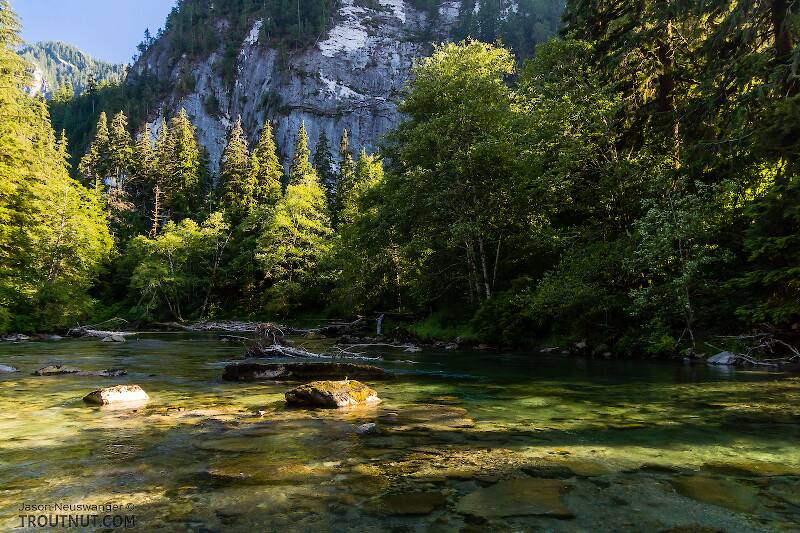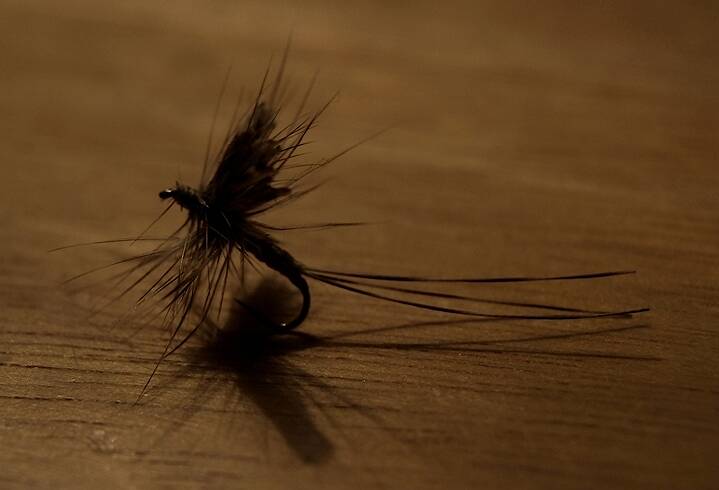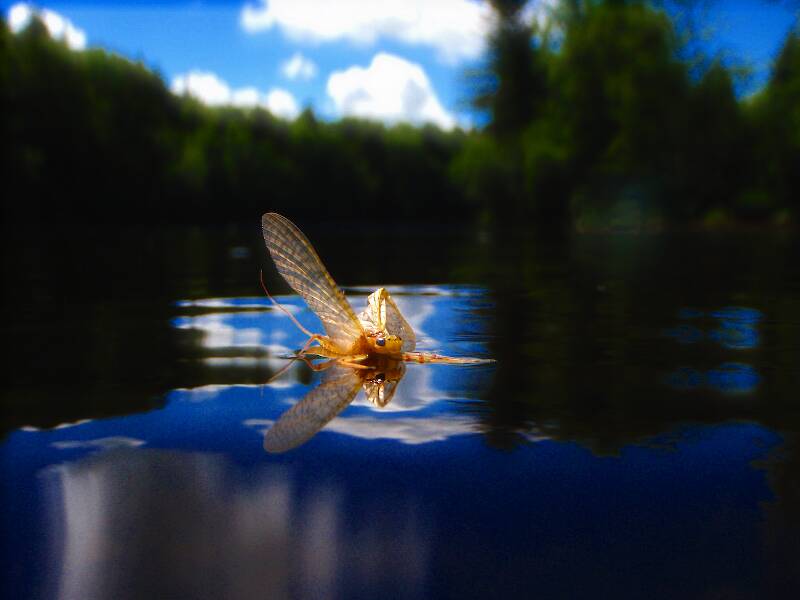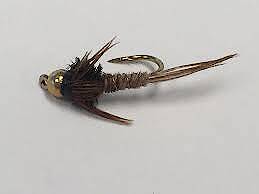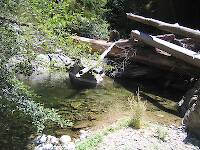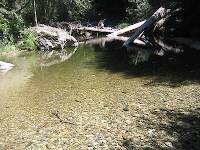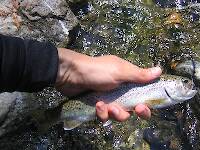
Blue-winged Olives
Baetis
Tiny Baetis mayflies are perhaps the most commonly encountered and imitated by anglers on all American trout streams due to their great abundance, widespread distribution, and trout-friendly emergence habits.
Featured on the forum

Troutnut is a project started in 2003 by salmonid ecologist Jason "Troutnut" Neuswanger to help anglers and
fly tyers unabashedly embrace the entomological side of the sport. Learn more about Troutnut or
support the project for an enhanced experience here.
FisherOfMen on Mar 4, 2014March 4th, 2014, 1:52 am EST
Tonight I watched a few videos about furled leaders, and how well they transfer the energy bc they are essentially limp.
However, they insisted on using a 4-5 ft tippet section for clear water because of the white and thicker leader
Now wouldn't that long of a tippet ruin the energy transfer to the fly? I'm thinking of ordering some furled leaders so if you're bored let me know your guys' experience with them and how you think the fish were affected by a visible leader.
Thank you!!
However, they insisted on using a 4-5 ft tippet section for clear water because of the white and thicker leader
Now wouldn't that long of a tippet ruin the energy transfer to the fly? I'm thinking of ordering some furled leaders so if you're bored let me know your guys' experience with them and how you think the fish were affected by a visible leader.
Thank you!!
"Nothing makes a fish bigger than almost being caught." -Author Unknown
All that is necessary for the triumph of evil is that good men do nothing. -Edmund Burke
All that is necessary for the triumph of evil is that good men do nothing. -Edmund Burke
Al514 on Mar 4, 2014March 4th, 2014, 2:40 am EST
"Now wouldn't that long of a tippet ruin the energy transfer to the fly?"
If there isn't enough energy put into the cast, then yes...it may. Just like a standard 10-12' leader won't turn over properly without enough energy put into it.
My experience with furled leaders is limited to a few fishing sessions, but I always assumed to add tippet after the furled leader itself. I added probably 4 feet. The leader turned over fine, not much different than a standard leader, however there was one thing I don't like about those things which is why I don't like using them. I like casting at a rising fish and making my line "check" in the air so it lands with slack in the leader. The way a mono-filament leader will lay out, or "check", becomes fairly predictable, but I found that the furled leaders kind of have a mind of their own if you try and do this type of cast with them.
That's my only frustration with the things...I'm sure others have better input.
If there isn't enough energy put into the cast, then yes...it may. Just like a standard 10-12' leader won't turn over properly without enough energy put into it.
My experience with furled leaders is limited to a few fishing sessions, but I always assumed to add tippet after the furled leader itself. I added probably 4 feet. The leader turned over fine, not much different than a standard leader, however there was one thing I don't like about those things which is why I don't like using them. I like casting at a rising fish and making my line "check" in the air so it lands with slack in the leader. The way a mono-filament leader will lay out, or "check", becomes fairly predictable, but I found that the furled leaders kind of have a mind of their own if you try and do this type of cast with them.
That's my only frustration with the things...I'm sure others have better input.
FisherOfMen on Mar 4, 2014March 4th, 2014, 3:44 am EST
Thanks Artie~
Another thing I've been wondering: I see some leaders with a strip of red line between the fly line and leader or leader and tippet.. I'm assuming this is used as a strike indicator of sorts? What type of setup do you guys use when adding the bright indicator line to your leader?
Another thing I've been wondering: I see some leaders with a strip of red line between the fly line and leader or leader and tippet.. I'm assuming this is used as a strike indicator of sorts? What type of setup do you guys use when adding the bright indicator line to your leader?
"Nothing makes a fish bigger than almost being caught." -Author Unknown
All that is necessary for the triumph of evil is that good men do nothing. -Edmund Burke
All that is necessary for the triumph of evil is that good men do nothing. -Edmund Burke
Al514 on Mar 4, 2014March 4th, 2014, 4:11 am EST
The "Indicator Mono" is exactly what you think it is. Designed for long rods and "European" style fishing, the indicators can be coiled or tied in straight. Unlike the furled leaders, I do have a lot of experience with this type of rig...very effective if fished correctly. A long rod definitely helps...it extends your drifts and your casting will be easier. I would say anywhere from 9.5ft - 10.5ft is a good place to start.
Here is my basic rig using the indicator mono, starting with the fly line (which, in my opinion, when fishing this style makes a HUGE difference). The tip should have a very fine diameter with a long front taper. I know guys use DT 2 / 3 WT lines for this style of fishing. Cortland makes the Competition Nymph line which is designed specifically for European fishing. If the waters you're fishing don't have any restrictions on the leader length, you might want to try adding about 10'-15' of 20-25lb maxima off the end of the line, which would be about what you end up "casting" with this rig. The mono won't droop down like a traditional WF line would. You want the line to stay as taught as it can as far away as it can in some situations.
After the line I attach 4-5 FT of leader depending on the flies / rod / tippet diameter you have available, etc. I like to connect the indicator mono, regardless of its size, to .015'' leader material on the top end. I usually drop 4ft of 4x off the other end of the indicator mono and start adding in my flies.
The entire rig is designed to be fished facing upstream, high-sticking a taught line as it drifts back to you. It may take a few bites for you to realize when to set the hook, but once you figure it out it is a deadly method.
Here is my basic rig using the indicator mono, starting with the fly line (which, in my opinion, when fishing this style makes a HUGE difference). The tip should have a very fine diameter with a long front taper. I know guys use DT 2 / 3 WT lines for this style of fishing. Cortland makes the Competition Nymph line which is designed specifically for European fishing. If the waters you're fishing don't have any restrictions on the leader length, you might want to try adding about 10'-15' of 20-25lb maxima off the end of the line, which would be about what you end up "casting" with this rig. The mono won't droop down like a traditional WF line would. You want the line to stay as taught as it can as far away as it can in some situations.
After the line I attach 4-5 FT of leader depending on the flies / rod / tippet diameter you have available, etc. I like to connect the indicator mono, regardless of its size, to .015'' leader material on the top end. I usually drop 4ft of 4x off the other end of the indicator mono and start adding in my flies.
The entire rig is designed to be fished facing upstream, high-sticking a taught line as it drifts back to you. It may take a few bites for you to realize when to set the hook, but once you figure it out it is a deadly method.
Martinlf on Mar 4, 2014March 4th, 2014, 10:48 am EST
Or, you can just use a 9' 0X leader as described by George Daniels, add the indicator tippet, or sighter, then 4-5 feet of 4X-6X tippet, and nymph with that. I used that set up last season and it worked for me. I've fished with the very long French style leaders a little, and am experimenting some with a Hends Camou 900 cm leader this season. You have to get the timing just right to cast a very long leader, especially for some casts where you don't have much fly line out of the top guide, and are actually casting just the leader. It takes, in my experience, a longer pause at the back, to straighten out the loop more, then a bit more speed on the forward stroke. I agree that this kind of rig can be very effective under the right conditions, if you get the drift right.
"He spread them a yard and a half. 'And every one that got away is this big.'"
--Fred Chappell
--Fred Chappell
Hunter1 on May 31, 2014May 31st, 2014, 5:30 am EDT
I use furled leader's. Nymphing i use a 4' section of tippet. cast like a pro with it, double rigs, any thing.Dry fly leader ,I use about 8'-9' of appropriat tippet. Rig cast great. All i know is that since I started to use them, I cast better.
Cptenn94 on Apr 28, 2015April 28th, 2015, 2:38 pm EDT
Fisher of men
I recently bought 2 furled leaders that I have yet to try them out much.
I will let you know what I find out about how different it feels and acts for me.
The leaders I bought I got from 2 different makers. I am excited to try out one of the leaders I got which makes a special kind of furled leader which is made a unique way.
So I have a furled leader that is uniquely made, and a furled leader that is made with a red line near the butt section, that is primarily made for nymphing.
Ultimately, the worst case scenario is that I have 2 tough durable leaders that I can always rely on as backups if I dont like them, and be less concerned about as I screw up casts time and time again.(as they should be very durable)
I would be more than happy to share the suppliers I purchased them from online.
I recently bought 2 furled leaders that I have yet to try them out much.
I will let you know what I find out about how different it feels and acts for me.
The leaders I bought I got from 2 different makers. I am excited to try out one of the leaders I got which makes a special kind of furled leader which is made a unique way.
So I have a furled leader that is uniquely made, and a furled leader that is made with a red line near the butt section, that is primarily made for nymphing.
Ultimately, the worst case scenario is that I have 2 tough durable leaders that I can always rely on as backups if I dont like them, and be less concerned about as I screw up casts time and time again.(as they should be very durable)
I would be more than happy to share the suppliers I purchased them from online.
Quick Reply
Related Discussions
Topic
Replies
Last Reply

